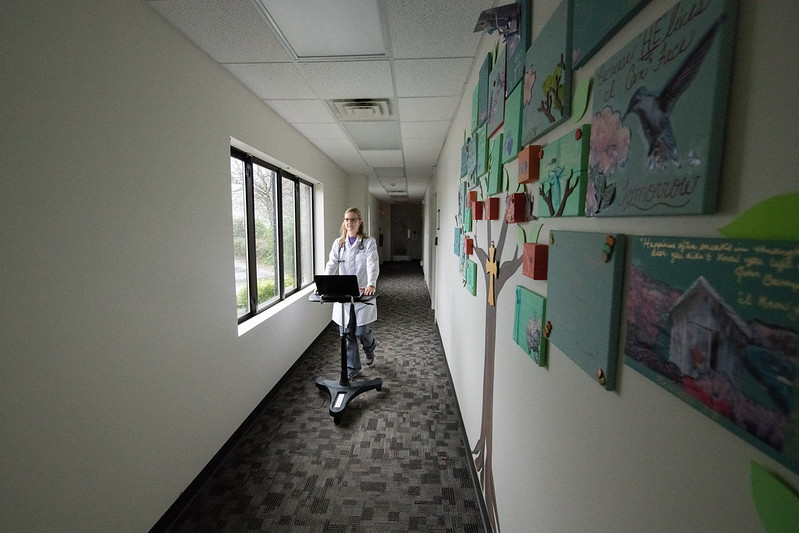Updated June 18 at 11:30 a.m. PST.
Feminists have been fighting a defensive battle to protect abortion rights for years—but today some are taking the offense, pushing to expand abortion access by calling for the removal of FDA restriction on the abortion pill mifepristone.
Formerly known as RU-486, mifepristone ends pregnancy by blocking the effects of the hormone progesterone, which sustains pregnancy. Used in combination with another drug—misoprostol, which causes contractions to complete an abortion—mifepristone is extremely safe.
After a long fight by anti-abortion activists to block the drug from the U.S. market, the FDA approved mifepristone for use within the U.S. in 2000, but placed the drug under a regulatory restriction called Subpart H, later called the Risk Evaluation and Mitigation Strategy (REMS) drug safety program.
Under this restriction, the FDA prohibited retail pharmacies from stocking and distributing mifepristone, instead requiring mifepristone to be dispensed in a doctor’s office, clinic or hospital registered with the drug manufacturer. The FDA allowed use of mifepristone only in the first seven weeks (or 49 days) of pregnancy and required patients to take the medication in the doctor’s presence. This meant patients had to make multiple visits to their healthcare providers.
In 2016, during the final days of the Obama administration, the FDA loosened restrictions on mifepristone by extending the time period during which the drug could be used to 10 weeks (or 77 days), allowing a lower dose of the drug (from 600 mg to 200 mg)—meaning fewer side effects—and allowing fewer visits to the doctor. The former protocol required three doctor’s visits; the new regulation allowed patients to obtain a medication abortion in just two.
Despite the ongoing REMS restriction on mifepristone, the use of medication abortion has increased significantly over time: It now accounts for approximately 40 percent of all recorded abortions and 60 percent of abortions performed up to 10 weeks gestation in 2017—although the rate is likely higher because of self-managed abortion, which is not recorded.
Fighting the REMS Restriction
Reproductive health advocates argue that the REMS restriction is based on politics, not medical evidence. Whereas REMS is meant to restrict dangerous drugs, mifepristone is an extremely safe drug. In fact, mifepristone is six times safer than Viagra—which the FDA does not restrict under the REMS program.
Advocates are pursuing multiple strategies to challenge the REMS restriction:
Challenging the FDA Restriction in the Courts
One approach has been to take the FDA to court.
In 2017, the ACLU challenged the FDA REMS restriction on mifepristone in the case of Chelius v. Azar. In the complaint, brought on behalf of providers and patients in Hawaii, the ACLU argued that the REMS restriction violates the rights to liberty, privacy and equal protection guaranteed by the U.S. Constitution by imposing significant burdens on abortion access without proof of a valid medical justification. This lawsuit is ongoing.

Then on May 27, the American College of Obstetricians and Gynecologists (ACOG) filed a lawsuit challenging the FDA restriction. Joined by the Council of University Chairs of Obstetrics and Gynecology, the New York Academy of Family Physicians, and SisterSong Women of Color Reproductive Justice Collective, ACOG is asking a federal district court in Maryland to order the FDA to lift the REMS restriction on mifepristone during the COVID-19 crisis.
“Our request in this case is simple: the federal government should permit patients seeking safe and effective reproductive health care, which includes care for miscarriage and termination of pregnancy, the same ability to access care and protect themselves from exposure as patients in other contexts are afforded,” said Eva Chalas, MD, FACOG, FACS, president of ACOG.
“Lifting the barriers to mifepristone will allow women, including those from underserved communities that are disproportionately affected by both COVID-19 and the ongoing maternal health crisis, the ability to obtain necessary and essential evidence-based care without having to risk potential life-threatening exposure.”
Lobbying the FDA to Remove the Restriction
Multiple groups are pressuring the FDA to release mifepristone from the REMS classification, arguing that the unnecessary requirements place people at particular risk during the COVID-19 crisis.
On April 6, the National Women’s Health Network (NWHN) coordinated 80 women’s health organizations to write a letter to FDA Commissioner Stephen Hahn demanding that the FDA remove the REMS restriction on mifepristone and requesting a meeting with Hahn.

The NWHN has a social media campaign called “Get the Pill Where You Take It—At Home!” with the hashtag #FreeTheAbortionPill, a video, a petition and digital billboards in New York state.
On April 27, Pearson teamed up with former FDA Assistant Commissioner for Women’s Health Susan Wood in an opinion piece published in The Hill entitled, “The U.K Allows Home Use of the Abortion Pill—the U.S. Should Do the Same.”
Noting that at the end of March, the United Kingdom authorized physicians to provide medication abortion through telemedicine through the duration of the coronavirus crisis, they argued that in light of the pandemic the FDA “should allow pregnant people to get the pill where they take the pill—at home—and not require them to make an unnecessary and risky visit to a clinic.”
Public officials have also sounded off: On March 30, twenty-one state attorneys general sent a letter to Hahn, demanding the FDA remove the REMS restriction.
Then on April 14, Senators Patty Murray (D-Wash.), Elizabeth Warren (D-Mass.) and Tammy Baldwin (D-Wisc.) sent their own letter asking the FDA to lift the restriction during the pandemic.
And on Tuesday, June 16, a group of 109 lawmakers, led by U.S. Reps. Diana DeGette (D-Colo.), Barbara Lee (D-Calif.), Ayanna Pressley (D-Mass.), and Jan Schakowsky (D-Ill.) sent a letter urging the FDA to permanently ease the dispensing restrictions on mifepristone.
“The REMS in its current form creates an illogical situation in which a patient can meet with her doctor by telehealth from the safety of her home, take the pills at home, safely have her abortion at home, and follow up with her doctor after the abortion by telehealth again, but must first travel in the midst of a global pandemic just to pick up the pills from a registered facility or provider,” the lawmakers wrote to FDA Commissioner Stephen Hahn.
“For many patients, this requirement can mean taking public transportation, riding in someone else’s car, or traveling hundreds of miles away from home to another county or state—significantly increasing their risk of exposure to the virus. It also means that some providers and clinic staff are forced to have unnecessary in-person interactions that increase their own exposure risks.”
Reinterpreting the FDA’s REMS Requirement to be Less Restrictive
Until recently, the consensus was that the REMS restriction required medical providers to meet with their patients twice: once to dispense the abortion pill to them in person, and a second follow-up appointment to confirm the successful termination of the pregnancy.
In addition, standard medical protocols recommended an ultrasound and Rh blood test before medication abortion was administered, which require office visits. These protocols limited the use of telemedicine abortion.
But medical providers and health advocates are now challenging these interpretations and standards, spurred by the COVID-19 pandemic.
The organization Plan C is arguing that the REMS restriction does not bar doctors from mailing the abortion pill to patients.
In addition, reproductive health providers are advocating for better, science-based medical protocols that do not require in-person tests. ACOG issued guidance on March 30 stating that clinicians can perform an assessment, counseling and consent for medication abortion by video or telephone, and that an ultrasound and Rh testing is not necessary.
Similarly, the Reproductive Health Access Project has issued a “no-touch” medication abortion protocol that does not require in-person visits and tests.
Cynthia Pearson, executive director of the National Women’s Health Network, told Ms. that the FDA REMS restriction on mifepristone does not explicitly require providers to perform ultrasounds.
“I believe that the assumption that an ultrasound was required was a result of community standards, under which most clinicians used ultrasound to date pregnancies,” said Pearson.
In fact, the tests are often not necessary because patients can reliably tell their doctors when their last period began (to determine gestational age) and their blood type.
Expanding the REMS Research Exception
In 2016, Gynuity Health Projects launched a research study on telemedicine abortion called TelAbortion. The Obama administration’s FDA allowed the study to commence as a New Drug application, where clinicians participating in the study would provide medication abortion care by videoconference and mail.

The study began in four states: New York, Hawaii, Oregon, Maine. Preliminary results of the study, published in September of 2019, showed that the direct-to-patient telemedicine abortion service was safe, effective, efficient and satisfactory.
The TelAbortion study has since expanded to nine more states, including Washington, New Mexico, Colorado, Georgia, Iowa, Minnesota, Illinois, Maryland and Montana, and they plan to expand to more states soon.
Supporting Self-Managed Abortion
Other reproductive health organizations are advocating for self-managed abortion. Feminist organizations—like SASS, Plan C, Aid Access and M+A Hotline—are providing people with information about how to self-manage their abortions, including information about how to use the abortion pill, where to purchase the pills online, and medical supervision from doctors outside of the country.
Because some states prosecutors have charged women with crimes for using the abortion pill, the organization If/When/How: Lawyering for Reproductive Justice is offering legal representation and calling for the decriminalization of people who self-manage their abortions using pills bought online.
Why Is It Important to Remove the REMS Restriction?
While new interpretations of the REMS restriction offer promise for reducing barriers to medication abortion, these strategies still leave a patchwork of access where many people are left out, often the most marginalized people.

“Policies need to work for all women, including women who have trouble getting time off work, who have trouble traveling, who have limits on their financial situations,” Pearson told Ms. “To help those that need it most, the REMS restriction needs to be gone.”
Pearson also expressed concern that the REMS restriction might discourage some doctors from providing medication abortion because they don’t want to be on a registry that could be made public, making them and their families the target of anti-abortion harassment and violence at clinics and even at their homes.
“Abortion providers are singled out for public attacks, including violent attacks. It’s common sense that that would stand in the way of at least some providers who might be willing otherwise write prescriptions for mifepristone.”
While the list of mifepristone providers is supposed to be confidential, some provider may fear that anti-abortion politicians would try to obtain the lists of providers from drug manufacturers and then make their names public.
Finally, Pearson said that the REMS needs to go because it stigmatizes medication abortion, and contributes to the misperception that medication abortion is dangerous, which it is not.
“The fact that the FDA has kept medication abortion in a restricted access program for 20 years contributes to that false sense of abortion as being dangerous.”
The REMS restriction isn’t the only barrier to medication abortion. Eighteen states currently require the prescribing clinician to be physically present when prescribing the abortion pill. Thirty-three states require the clinician prescribing the abortion pill to be a physician.
But removing the REMS restriction would go a long way to making medication abortion more accessible, including via telemedicine, and increasing safety during COVID-19.
“The REMS restriction has been wrong for 20 years,” said Pearson. “It is extra wrong now.”





